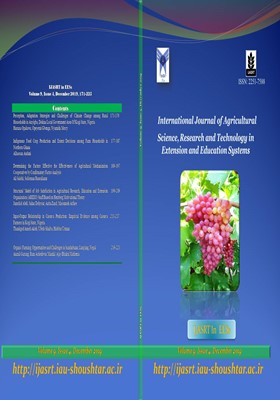Determining the Factors Effective the Effectiveness of Agricultural Mechanization Cooperatives by Confirmatory Factor Analysis
محورهای موضوعی :
Management in Extension Systems
Ali Salehi
1
,
Solieman Rasouliazar
2
1 - Department of Agricultural Mechanization, Mahabad Branch, Islamic Azad University, Mahabad, Iran
2 - Department of Agricultural Management, Mahabad Branch, Islamic Azad University, Mahabad, Iran
تاریخ دریافت : 1398/09/12
تاریخ پذیرش : 1398/09/26
تاریخ انتشار : 1398/10/09
کلید واژه:
effectiveness,
factors,
Mechanization,
Agricultural Cooperatives,
Mahabad,
چکیده مقاله :
Cooperative organizations play an important role in improves the quality of work, especially in agricultural sector. The main purpose of this research was to determining the effective factors on the effectiveness of agricultural mechanization cooperatives (EAMC) in the Mahabad township that located in west Azerbaijan province. The research population included farmers that member agricultural cooperatives in Mahabad township in the West Azerbaijan Provinces (N = 18758). By using Cochrane formula sample size was determined as 215 people. The data collection tool was the questionnaire. Reliability coefficient of the questionnaire was obtained by Cronbach's alpha that was 0.769. Results showed that factors influencing the effectiveness on agricultural mechanization cooperatives (EAMC) include management, economic, social, policy-making and educational factors. Also finding of confirmatory factor analysis by lisrel shows that the highest value of R2 = 0.72 was related to the policy making factor and the lowest value of R2 = 0.42 was related to economical factor.
منابع و مأخذ:
Abdulquadri, A.F., and Mohamad B.T. (2012). The Role of Agricultural Cooperatives in Agricultural Mechanization in Nigeria. World Journal of Agricultural Sciences 8 (5): 537-539.
Akinbamowo, R. O. (2013). A review of government policy on agricultural mechanization in Nigeria. Journal of Agricultural extension and Rural Development. 5 (8):146-153.
Almasi, M. (2001). Principle of agricultural Mechanization. HazratMasomeh Publication. Tehran. Iran.
Amadi, C. A., Onogwu V., Orisakwe, K.U and Zaku, S. (2014). Factors Influencing Mechanized Farming and Farm Size Ownership in Nigeria. Journal of agriculture and Sustainability. 4(2): 227-234.
Amini, A. And Ramazani, M. (2006). Investigation the causes of the success of cooperatives and in Mazandaran and Golestan provinces. Journal of Agricultural Sciences and Natural Resources, 13(2): 1-11.
Amini, A., and Ramezani, M. (2006). Investigation the causes and successful of agricultural cooperatives poetry in Mazandaran and Golestan Province. Journal of agricultural science and natural resources. 13(2). Pp: 1-11.
Amjadi, A., Chizari, A, H. (2006).Agricultural mechanization situation in Iran. Journal of agricultural economic and development. 14 (55). Pp: 155-182.
Anderson, R. J., (2008). Agricultural advisory services. A Background Paper for World Development report. http://siteresources.worldbank.org/INTWDR2008/Resources/2795087- 1191427986785/Anderson_AdvisoryServices.pdf
Bageri, N., Moazen, S. (2010). The optimal strategy for the development of agricultural mechanization in Iran, Proceedings of the Fifth National Conference on Agricultural Machinery Engineering and Mechanization. Paper code 13.
Bayati, M., Ghorbani, M and Shahnoshi, N. (2007). Agricultural mechanization advisory cooperatives, capabilities and problems (case study Khorasan Province). Journal of Tavon. 21(2). Pp: 1-2.
Bigdelli, A., Zaranejadm M., Asvadar, M., Baserzadeh, H and Baradaran, M. (2007).Investigation the development of agricultural mechanization in Hamadan. Journal of agricultural research. 30(2). Pp: 119-131.
Chisango, F.F.T. and Obi, A. (2010). Efficiency Effects Zimbabwe’s Agricultural Mechanization and Fast Track Land Reform Program: A Stochastic Frontier Approach. Poster presented at the Joint 3rd African Association of Agricultural Economists (AAAE) and 48th Agricultural Economists Association of South Africa (AEASA) Conference, Cape Town, South Africa, September 19-23.
Ebadzadeh, H., Ahmadi, K., Mohamadniya, Sh., Abastaleghani, R., Abasi, M and Yari, Sh. (2018). Statistics of Agricultural Jihad. Deputy of Planning and Economic Affairs. Information and Communication Technology Center. Tehran.
Havrland, B., Kavka, M and M, Ruzicka. (2006). Influence of factors on the maize-grain mechanized technology net margin. Journal of research in Agriculture. 2:69-79.
Liu, Z., Yang, D. and Wen, T. (2019), "Agricultural production mode transformation and production efficiency", China Agricultural Economic Review, Vol. 11 No. 1, pp. 160-179. https://doi.org/10.1108/CAER-07-2017-0129
16. Merzaiy, R.; Sadighi, H.; Phalsaphi, P., (2008). Assessment of agricultural extension systems of Iran. Agricultural Extension and Education Journal,.2 (3): 57-67.
Mohamadi, A., Zarifiyan, Sh. (2006). Study the management status and affective factors on land mechanization (case study in Nishabor). M.Sc Thesis. Agricultural Management, Tabriz University.
Nekoeynaeniy, A., Alibegi, A., and Zarafshani, K. (2007). Analysis affective factors of success of rural cooperatives in Kermanshah city. Journal of rural development. 12(4):1-22.
Peshbien, S., Mohamadi, M., Ejraey, A and Shirzazi, M.H. (2008). Economic analysisof mechanizationandtechnical efficiencyin sugar beet fieldsCase Study inFars Province. Journal of sugar beet. 2(24): 129-146.
Rasouliazar, S and Marofi, E. (2018). Agricultural Marketing in agriculture. Norozi Publication. Tehran.
Sabet, D., Ansari, H, and Azkia, M. (2010). Investigation the satisfaction members about the economic and social performance in rural cooperatives. Journal of cooperative, 21(2):17-36.
Taherkhani, M. (2007). The role of production cooperatives in development of rural region. Journal of Geographical researches. 49 (2): 115-126.
Terameshlo, M., Lashgarara, F., and Merdamadi, S.M. (2016). The Role of Rural Production Cooperatives in Agricultural Development in Qom Province of Iran. Journal of rural and Development. 18(2):111-127.


